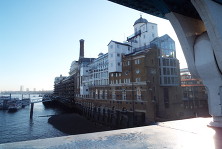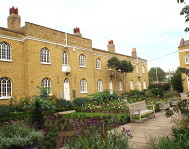








Fire Station and Winchester House,
Southwark Bridge Road
Opened in 1878, the fire station in Southwark Bridge Road closed in January 2014, one of 10 fire stations in London closed as a result of a directive by Mayor of London, Boris Johnson. The entire site of the former fire station, measuring a total of 2.17 acres, was subsequently put up for sale. The site includes Winchester House, former home to the Fire Brigade Museum, which has a long history dating back to the 18th century. Both
the fire station and Winchester House are Grade II listed.
On the corner of Southwark Bridge Road and Sawyer Street, next door to the fire station, is a pub called the Goldsmiths Arms. This is the site of the former Finch’s Grotto, a place of entertainment in the 18th century with gardens where there was a spring whose water was said to have health giving properties. A grotto was built over the spring and a fountain directed the waters from the spring to cascade over artificial embankments. The garden was planted with shrubs and trees, and extended over the area where Winchester House is today. But though popular and to a certain extent respectable, the Grotto failed and in about 1777 St Saviour’s Parish purchased the gardens for the site of a new burial ground, called for a while the New Grotto Burial Ground. Next to the burial ground a new workhouse was built, designed by George Gwilt the elder, which was described as being located at the end of Pepper Street (Southwark Bridge Road had not yet been constructed.) Concannon and Morgan in A History and Antiquities of the Parish of St Saviour, Southwark, written in 1795, described the workhouse as:
"... a spacious and convenient building situated at the upper end of Pepper Street; this house was finished and rendered fit for the reception of the poor, and they were first removed into it in the year 1777. The erecting it is said to have cost the parish five thousand pounds. The burying ground adjoining to it was consecrated by Dr John Thomas, bishop of Rochester, on the 27th July, 1780.
"... From a view of this house compared with others, we were led to remark, that those who are able, are employed on work suitable to their ability, supplied with warm and very cleanly lodging, sufficient cloathing, and provisions of very good quality. The work rooms, which consist of various employments, winding silk, carding wool, coarse needle-work, etc are under the inspection of persons employed for the purpose, but who belong to the house, and they seem to be conducted with decency and industry. The various accommodations are very convenient; the kitchen, dining-hall, and store-rooms are decent, cleanly, and adequately supplied with what is necessary. The bread consumed is baked in the house. There is a neat committee room for transacting parochial concerns.”
The land the workhouse was built upon was part of Winchester Park owned by the Bishop of Winchester. The land was leased out and then parcels of land were sub-leased. The Parish of St Saviour’s held the land the workhouse was built upon on a sub-lease which was due to expire in the early 19th century. By this time, there had been a change in head lessee and the area was now in demand for commercial premises which were able to bring in a higher rent. As a result, the St Saviour’s Workhouse Committee were unable to agree terms and had no alternative but to vacate the workhouse. New premises for the workhouse were found in Rockingham Street.
The former fire station in Southwark Bridge Road. The original station buillt in 1878 is to the right and the extension, built in 1911, is to the left.
The former workhouse was leased by hat manufacturer John Rawlinson Harris who turned it into a hat factory and a dwelling for himself. Southwark Bridge and the approach road on the south side of the river, Southwark Bridge Road, opened in 1819. The former workhouse building is U-shaped and, about the time the bridge and new road were built, the eastern wing that faced onto the new road, what we know as Winchester House, was converted into two houses with embellishments to the front elevation that hid its origins as a workhouse. Four ionic pilasters and a balustrade were added, and a porch supported by doric columns at the entrance to each of the two houses to give us the façade we recognise today. It was about this time the building became known as Winchester House.
Winchester House, former home to the Fire Brigade Museum
The Borough, Union Street in particular, and the area around Blackfriars Road was a centre for the manufacture of hats (see The Mad Hatter Hotel). John Rawlinson Harris came from a family of hat manufacturers and had inherited the business. Although brought up as a Quaker, the Quakers disowned him in 1814 when he married outside the church. He subsequently became part of the congregation at St Saviour’s and was ‘greatly esteemed’ as the chief Churchwarden. He stood as MP for the Southwark constituency in 1830, and without aligning himself to any political party,
he supported abolition of slavery and supported ‘moderate and temperate reform, and economy in the public expenditure’. He was the surprise winner of the election and his victory was celebrated by a cavalcade and a celebratory dinner. It seemed to have been all too much for him and he died from typhus fever in August 1830 before he was able to take his seat in Parliament. The family hat manufacture business was left to his son John Quincey Harris.
In 1878 Winchester House became the headquarters for the London Fire Brigade and provided a residence for the its first Chief Officer, Eyre Massey Shaw. The Metropolitan Fire Brigade had only become a public service under the authority of the Metropolitan Board of Works in 1866, before this time insurance companies had provided the service for fighting fires. As a consequence of the Great Fire of Tooley Street in 1861, the insurance companies felt they were no longer able to take responsibility for this and felt the task should come under the control of a public authority. A fire station was built on Southwark Bridge Road to the south of Winchester House in 1878 by the Metropolitan Board of Works and a further extension built in 1911 on newly acquired land that extended as far as to the Goldsmiths Arms.
The London Fire Brigade headquarters moved from Winchester House to a new building on Albert Embankment in 1937 and then again to a former Royal Mail sorting office in Union Street, just around the corner from Winchester House, in 2007. The Fire Brigade Museum was established in Winchester House in 1966 but, with redevelopment planned for the whole site, has now closed with plans to establish the museum in the former headquarters building on Albert Embankment.
After 140 years, with the fire station already closed, the Fire Brigade now has no presence on Southwark Bridge Road. Plans for what will happen to the site have still not been finalised but have aroused controversy regarding the Mayor’s role in negotiations. It appears that at least some of the site will be used to open a new school.
Web discoveries
- UK Casino Not On Gamstop
- UK Casino Not On Gamstop
- Non Gamstop Casino
- Casinos Not On Gamstop
- Non Gamstop Casinos
- Non Gamstop Casinos
- Non Gamstop Casino
- Casino Sites Not On Gamstop
- Slots Not On Gamstop
- Casinos Not On Gamstop
- UK Betting Sites Not On Gamstop
- UK Casino Not On Gamstop
- Best Non Gamstop Casinos
- Betting Sites
- Non Gamstop Casino Sites UK
- Best Non Gamstop Casinos
- Non Gamstop Casino
- Casinos Not On Gamstop
- Non Gamstop Casino Sites UK